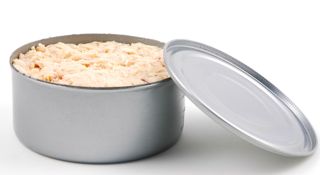
"Most children are already consuming only modest amounts of tuna and are not at significant risk," said Michael Bender, director of the Mercury Policy Project (MPP). "So the focus really needs to be on kids who eat tuna often, to limit their mercury exposure by offering them lower-mercury seafood or other nutritious alternatives."
In its report called "Tuna Surprise," MMP's first tests of canned tuna sold to schools assesses the exposure of children to mercury in canned tuna. Here's what it concludes:
- School children should not eat albacore tuna. Albacore or "white" tuna, according to MMP, contains three times more mercury than light tuna. The report says there is no justification for tripling a child's mercury dose.
- Children weighing less than 55 pounds should consume no more than one tuna meal per month. MMP says the less body weight requires an added margin of caution, especially appropriate for young children.
- Children weighing more than 55 pounds should limit their tuna intake to two servings per month. This amount is more than the average children currently consumes and the mercury dose it contains is an acceptably low risk.
- Tuna-loving children should be the "focus of risk management efforts" including taking steps to prevent children from daily consumption of tuna. Parents and schools should offer children other seafood choices, including shrimp and salmon. These choices are just as nutritious but with lower mercy levels.
- USDA should phase out the purchase of canned tuna and replace it with low mercury seafood alternatives.
- Parents should monitor the canned tuna consumption of their children to make sure their home and school consumption does not exceeded recommendations for exposure.
In the report, MPP tested the content of 59 samples representing eight brands of tuna sold to schools in 11 states.
"As far as we know, no one has previously tested this market sector," said Bender.
Testing showed that mercury levels of tuna sold to schools were similar to those in tuna sold by supermarkets. Albacore or "white" tuna had the higher levels of mercury than "light" tuna. Mercury levels in both types were said to be highly variable.
Clinical methylmercury poisoning is rare in America, but the "Tuna Surprise" study said such cases do exist.
Mercury in tuna has been a concern for years, with the best health advice usually centering on limiting one's intake. This new study, co-sponsored by the Center for Science in the Public Interest, focuses on some children that may be at greater risk than others.
"Fish, including tuna, is generally a nutritious part of a healthy diet," says Sarah Klein, staff attorney for the food safety program at CSPI. "But especially for out littlest, most vulnerable children, we have to make sure the risks from mercury in tuna don't outweigh tuna's benefits. We're urging parents and schools to limit children's tuna consumption and, when they do serve it, to choose lower-mercury options."
Eric Uram of Safe Minds, another sponsor, said light tuna contains one-third as much mercury as albacore or "white" tuna. And the Tuna Surprise report clearly focuses on canned tuna as the largest source of mercury in the American diet.
On the positive side of the debate, it said canned tuna is an inexpensive and nutritious source of low-fat protein. Americans eat twice as much canned tuna than any other kind of fish. One in every six seafood meals includes canned tuna.
"Kids who eat tuna frequently can easily get very high mercury doses," said Ned Groth, an environmental health scientist. He analyzed for the report various scenarios in which children of different ages ate different amounts of tuna with different mercury levels.
"Some of the larger doses are clearly far too high to be acceptable," Groth said.
Included in his study were levels from one quarter to more than 40 times the current federal levels for safe exposure.
A spokesman for the Physicians for Social Responsibility said, "It is a shame that such a great source of inexpensive protein is contaminated with mercury." In the meantime, he said, reducing children's exposure to tuna and controlling mercury pollution with fewer coal-fired power plants will be necessary.





